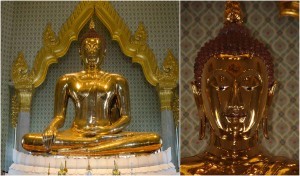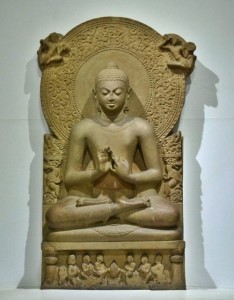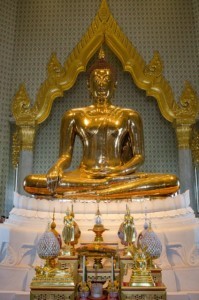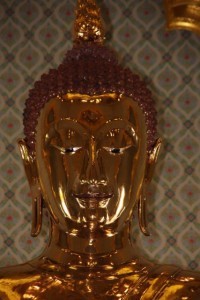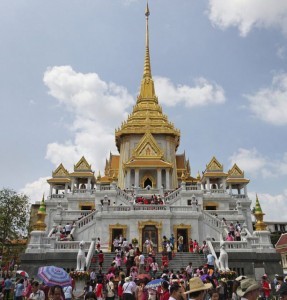The founder of Buddhism, Siddhartha Gautama of India, is believed to have lived from about 566 to 480 BC.
As a child born into royalty, he lived a privileged life. At one point in early adulthood, Gautama decided to search for the meaning of life. After several encounters, he decided that enlightenment existed at the end of suffering.
He renounced his privileged life and became a monk with no worldly possessions. One day, while he was meditating under a tree, he had a revelation regarding how to end suffering and attain redemption. From that point on, Gautama adopted the title “The Buddha” which translates as “Enlightened One”. According to PBS, he spent the rest of life teaching the Four Noble Truths – of suffering, of the cause of suffering, of the end of suffering, and of the path to the end of suffering. In the end, these truths lead to Nirvana – the ultimate enlightenment.
(Teaching Buddha (Dharmacakra mudrā). Gupta period. Sandstone, H. 160 cm. Archaeological Museum -ASI-, Sarnath, India)
Statues representing the Buddha are found all over the world, especially in countries with a large Buddhist population. According to Wikipedia, Cambodia and Thailand have the highest Buddhist populations per capita, with 97% and 93% respectively. Throughout the world, it is estimated that 488 million people follow Buddhism.
One Buddhist statue is the Phra Phuttha Maha Suwan Patimakon, a 9-foot tall Buddha weighing 5.5 tons and situated in the temple of Wat Traimit, Bangkok, Thailand (formerly Siam). It is in the traditional pose of Bhumisparsha Mudra, touching the earth with the right hand, as depicted in the story of Buddha’s enlightenment at Bodh Gaya. The flame atop the three-dimensional oval or turban at the top of the head of the Buddha, the ushnisha, represents the glory of spiritual energy. The lengthened earlobes are a sign of his former royal status.
(The golden buddha at Wat Traimit)
Because the head of the statue is egg-shaped, it is believed to have been created in the Sukhothai Dynasty style of the 13th and 14th centuries. Most scholars agree the Buddha statue was cast in India. Initially, it was located in Sukhin, but when the seat of power moved to Ayutthaya in about 1403, the Buddha moved with it.
(The shape of the statue’s head dates it to the Sukhothai period)
The Phra Phuttha Maha Suwan Patimakon statue was taken to Bangkok in 1801, when King Rama I of the House of Chakri in the Kingdom of Siam, a firm supporter of Buddhist monks, proclaimed Bangkok the new capital city. He ordered the construction of new temples in Bangkok and wanted the Buddha representations from the country’s ruined temples retrieved to be placed in the new temples. In the reign of his grandson, King Rama III, it was the principal Buddha image in the main temple of Wat Chotanaram in Bangkok.
Wat Chotanaram lost its popularity and was eventually abandoned. The statue moved to Wat Traimit in 1935, but since there was no place to keep the huge sculpture it sat outside, protected only by a tin roof for over twenty years. In May of 1955, the Buddha was being moved to a new building in Bangkok. When the statue was lifted from its pedestal, the ropes broke and it fell, causing the stucco to chip. When the installers inspected the damage, they had the surprise of their lives!
They chipped off more of the covering and discovered that underneath the plaster was a glint of gold. As they removed the rest of the stucco, they discovered a nine foot tall, 18-karat gold Buddha cast in nine parts. Included was a key to disassemble and reassemble the pieces. Photos taken to document the process are on display in the Temple, along with pieces of the stucco.
(The new building at the Wat Traimit temple)
Experts believe the statue was disguised to protect it from Burmese invaders in the mid-1700s – a successful ploy, as the figure was ignored and left in the rubble when Ayutthaya was destroyed. The discovery of the gold statue came very close to the 2,500 year anniversary of the death of Gautama Buddha and the find caused a media frenzy. Many devout Buddhists revere the discovery at this specific time as a true miracle.
To Buddhists and many others, the Golden Buddha is priceless. And its estimated monetary value alone is close to $250 million. The Temple of the Golden Buddha can be visited in Bangkok at the Golden Buddha Temple, a working monastery. The hours are 8 o’clock am to 5 o’clock pm every day.
Ask me anything
Explore related questions
